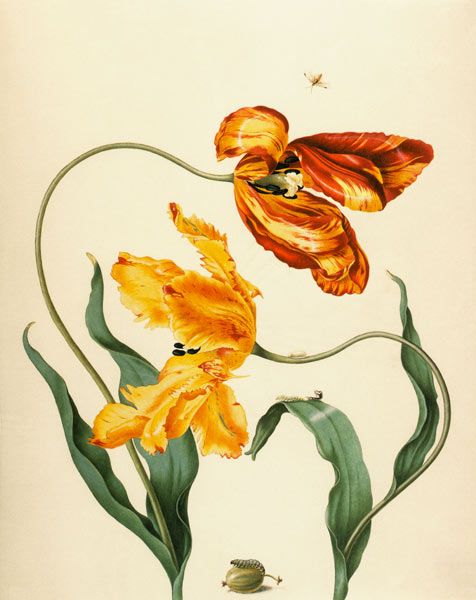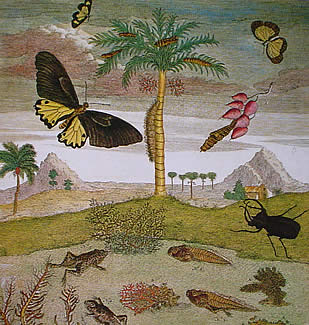I just finished reading
Chrysalis: Maria Sibylla Merian and the Secrets of Metamorphosis by Kim Todd. Maria Merian was born in Frankfurt, Germany and grew up in the family publishing business. Her artistic talents were encouraged and nurtured almost from the day she could hold a paint brush. Ms. Merian was also fascinated by butterflies, moths, caterpillars, and metamorphosis. As a young girl, Maria spent countless hours searching out caterpillars and cocoons to bring home, sketch, and observe, trying to unravel the mystery of insects.
Merian began working in her family's publishing business, learning the delicate task of engraving plates for printing and at the age of 28 published her first book, New Book of Flowers, a collection of her sketches, drawings, and paintings. Merian married early, began a family, moved to Nuremberg, divorced her husband, moved to a secluded cult compound, fled from there to Amsterdam, and finally, at the age of 52, travelled to Suriname in South America for the sole purpose of studying, painting, and exploring as many of the Amazonian butterflies, moths, and caterpillars as she could discover. She had metamorphosis fever.
Oh, did I mention that she left for Suriname in the year 1699? Yes, that's right, 1699.
Now, there are two things in life for which I have a special passion. One is obviously butterflies. The other is the Amazonian River Basin. It's been a fantasy of mine since childhood to travel up the Amazon River to it's source, or as close as I can get. I read whatever I can about the early exploration and history of the Amazon River Basin and I know from my readings that the Amazon jungle, even now, is no place for the weak of body or faint of heart. Though it is still a wild and dangerous place (sometimes in ways that have nothing to do with geography), the Amazon jungle defeated more early European explorers than can be counted. It is a beautiful yet brutal place. In those early years of exploration, the animals of the jungle such as leopards and snakes might get you but it was more likely that if the indigenous tribes didn't do away with you the insects and plant life would surely do the job. Savage, that's just all you can say about some of the ways the tiny fauna of the Amazon can dispense with you. And some of the fauna ain't so tiny.
Note- After a photo search, I have decided to skip over inserting a visual aid at this point as even I was getting a bit freaked out. No need to illustrate giant insects of the Amazon Jungle because I would like for y'all to come back to the Butterfly Jungle (where there are no giant insects).
With 90% of the animal species in the Amazon being insects, Merian was in her glory. A single square mile of rain forest has on average more than 50,000 insect species, with an estimated 4,000 of those being butterflies. Emphasis on "estimated". Merian had originally intended to stay in Suriname for five years and quickly established herself in the coastal capital of Paramaribo, developing relationships with the indigenous tribes along the rivers she travelled to the interior. Fearless, Merian hired guides to cut paths into the jungle. Merian sketched, painted, collected, observed, and interviewed. After only two years and weak from what was most likely malaria, Merian was forced to return home.

I picked up this book because the idea of a woman in her early 50's packing up and heading out into the Amazon Jungle in 1699 AD to study metamorphosis intrigued me- naturally. But this book is not just a biography of an acclaimed artist and self-taught entomology pioneer. It is also an exploration of the study of metamorphosis. At the time, the prevailing belief about where insects came from was that they arose from "spontaneous generation". In this context, "spontaneous generation" did not refer to the origin of life (life oozing up out of the primordial soup) but to the origin of the mice in your cupboard, for example. If you wrapped cheese and bread in rags and stashed them in a dark corner you would soon have mice in the rags and so- spontaneous generation of mice. Insects arose from rotting mud or fruit, old books, and dew. Old wool turned to moths, frogs arose from raindrops, flies were generated from old snow. Leave a woman's hair in the sunlight and it turned to snakes. Basil between two tiles held together with horse dung and placed in the cellar for a month gave you scorpions. To get a bee? Well, first you beat to death a three year old bull..... not kidding, there's a poem to help you remember the lurid details. These theories come from a casual observation of the natural world without a systematic investigation. Yes, if you leave trash in a heap you will get maggots but in the 17th century the curious-minded were only just beginning to say, "Wait a minute...." Bolstered by a growing contingency of theologians who reminded that all life was created by God, the debate and investigation were just getting under way. These early entomologists developed ingenious experiments to test their theories but Merian went a step further by seeking the association of caterpillar with its environment, the food it ate, the pupae they formed, the life that emerged from the cocoon. She sought to solve such mysteries as why, when she observed a caterpillar spin a cocoon, flies would on occasion emerge instead of a moth or butterfly. The depiction of these real life contexts are what made her paintings so revolutionary. Merian sought to depict all life stages from larva through the imago with the host plants in one painting. Merian's constant experimentation with pigments and style paved the way for her to soon be a much sought after and well-respected illustrator, in addition to her contributions to the understanding metamorphosis. During this period in history, insects were associated with witchcraft and the Devil, so Merian had to tread lightly to avoid being ostracized, particularly while she lived in Germany, where witch burnings were still taking place.
 |
Stages of an Emperor Moth: Metamorphosis Insectorum Surinamensis, Plate XI
Image via UH.edu |
The book concludes with a very interesting discussion on just what does happen during metamorphosis. Ms. Todd points out that it is the caterpillar, not the butterfly, that is the engine of metamorphosis. Please, I can't even start talking about metamorphosis because it is so cool and I'll just never shut up. HOWEVER- did you know that a caterpillar is not just a goo-filled eating machine but that there are components of the imago, the finished butterfly, in the caterpillar before it winds itself into a cocoon? Oh please, it's all so fascinating! It's the caterpillar that does all the metamorphing- the butterfly just steps out and gets all the glory!
The one disappointment about this book is that Merian's actual time in Suriname takes up only a small portion of the book. That disappointment most likely comes from my wanting to be there, to live vicariously through the descriptions of Merian's adventures and misadventures in the Amazon Jungle.
You can do an image search to explore more of Merian's paintings but I came across
ArtCyclopedia that links to online museum collections which contain her prints.
For the kids, there's
Summer Birds, Merian's story, by Margarita Engle.
Note- the books in this post link to Amazon but I am not an Amazon Associate and am not trying to sell you something so I can get one of those huge cuts of the pie from Amazon. The links take you to Amazon simply for your convenience should you be interested.
So OK, that's it. Go get a good book to read. See ya next time.








































byMargarita Engle, Julie Paschkis](http://ecx.images-amazon.com/images/I/516-RFbGUxL._SL500_AA300_.jpg)
